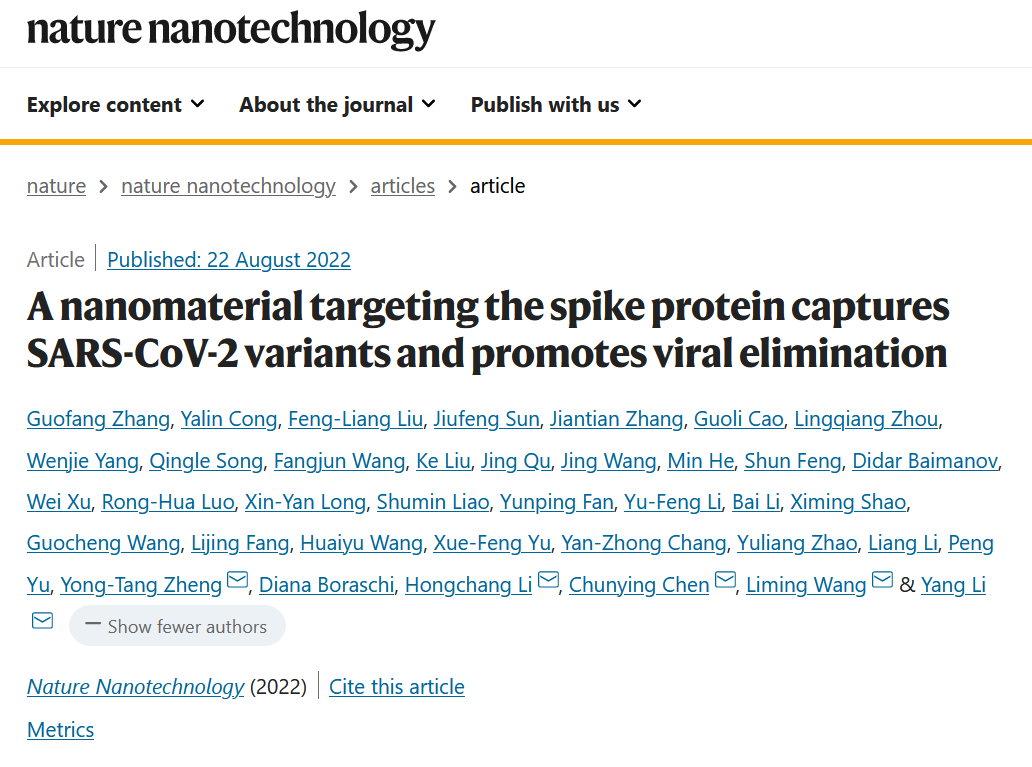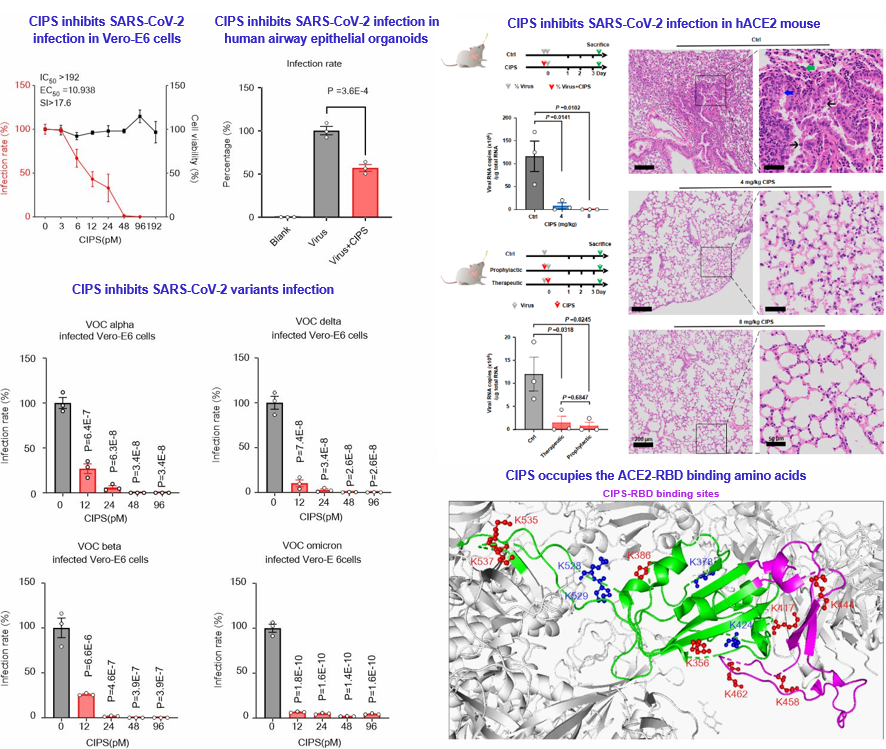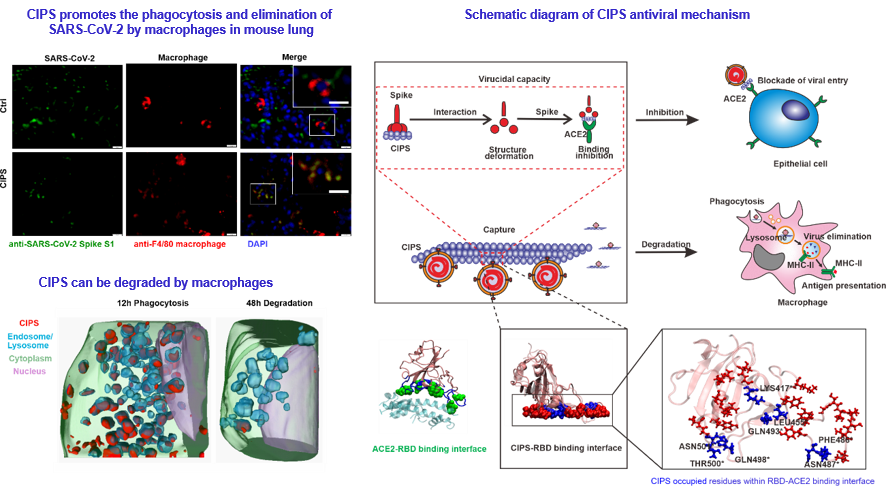Scientists Develop Novel Anti-Coronavirus Nanomaterial with Broad Spectrum and High Efficacy
Date:23-08-2022 | 【Print】 【close】
A joint research team led by Dr. LI Yang from the Shenzhen Institute of Advanced Technology (SIAT) of the Chinese Academy of Sciences (CAS) has developed a nanomaterial that could potentially be used as an effective COVID-19 therapeutic against SARS-CoV-2 variants.
The study was published in Nature Nanotechnology on August 22nd.

Researchers from the National Center for Nanoscience and Technology, the Institute of High Energy Physics, and the Kunming Institute of Zoology of CAS were involved in the study.
Coronavirus disease 2019 (COVID-19), induced by the severe acute respiratory syndrome coronavirus health crisis since the breakout from December 2019. The spread of SARS-CoV-2 variants of concern (VOCs), such as Alpha, Beta, Gamma, Delta and Omicron, is making the pandemic even worse. These VOCs challenge the efficacy of the current drugs and vaccines.
Despite drug repurposing efforts, alternative therapeutic tools with less specificity and a broader therapeutic capacity to target all VOCs are still needed to contain the pandemic caused by SARS-CoV-2.
In this study, the interdisciplinary research team and its collaborators have identified copper indium thiophosphate (CuInP2S6, CIPS) nanosheets (NS) as a spike protein-targeting nanomaterial that can be used to inhibit SARS-CoV-2 infection and promote SARS-CoV-2 host elimination.
As the key to SARS-CoV-2 host infection, the spike protein has become an important target for antiviral drugs. The researchers found that the CIPS could act as an effective "nano-glue" to selectively capture the SARS-CoV-2 virus by binding to its spike protein, thereby inhibiting the infection of host cells.
Notably, the affinity of CIPS for the SARS-CoV-2 spike protein receptor binding domain (RBD) (KD <1 pM) is substantially higher than that of therapeutic monoclonal antibodies, which normally ranges from 23 pM to 100 nM.

Figure 1. CIPS effectively inhibits the infection of SARS-CoV-2 and the variants in cells, human airway epithelial organoids and hACE2 transgenic mice. CIPS performs the antiviral capacity by occupying the ACE2-RBD binding amino acids. (Image by the joint research team)
The anti-SARS-CoV-2 effects of CIPS have been proven in cells, human airway epithelial organoids, and hACE2-transgenic mice models. The researchers also revealed the specific inhibitory mechanisms of CIPS: It effectively binds with eight out of 11 ACE2-binding amino acid residues of the SARS-CoV-2 RBD, thus efficiently inhibiting viral infectivity.
The RBD mutations displayed by SARS-CoV-2 VOCs do not affect their binding to CIPS, thus did not affect the therapeutic effect of CIPS against the viral VOCs.
Moreover, CIPS can work as a scavenging agent for SARS-CoV-2 host elimination.
"The SARS-CoV-2 captured by CIPS can be more efficiently phagocytosed by macrophages," said Prof. CHEN Chunying, a leading scientist of this interdisciplinary team, is the co-corresponding author from National Center for Nanoscience and Technology, "shuttled to phagolysosomes, and completely degraded together with its carrier." Thus, the capacity of CIPS to direct the virus to macrophages not only promotes viral destruction, but also triggers antiviral adaptive immunity.
The biocompatibility and biosafety of CIPS have also been extensively studied. CIPS has been proved to be safe both in vitro and in vivo, and can be degraded quickly in the lung and eliminated through urine. CIPS also did not induce any hematotoxicity or immunotoxicity after intranasal administration, demonstrating that it is a promising drug candidate for COVID-19 treatment. However, CIPS still needs to be tested with a series of clinical trials before it goes into market as a real drug.

Figure 2. CIPS promotes the phagocytosis and elimination of SARS-CoV-2 by macrophages in vitro and in vivo. The schematic diagram of CIPS antiviral mechanism. (Image by the joint research team)
"CIPS is a safe, biocompatible and biodegradable nanomaterial capable of inhibiting the infection and promoting the elimination of SARS-CoV-2 variants," said Dr. LI Yang, who noted it could be a potential drug candidate for restraining the global pandemic.
Media Contact:
ZHANG Xiaomin
Email:xm.zhang@siat.ac.cn